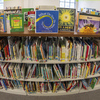The hippos ban the giraffes in Raj Haldar’s new picture book This Book Is Banned.
Sourcebooks
hide caption
toggle caption
Sourcebooks


The hippos ban the giraffes in Raj Haldar’s new picture book This Book Is Banned.
Sourcebooks
A silly new children’s picture book introduces little kids to a serious topic.
This Book Is Banned by Raj Haldar with pictures by Julia Patton isn’t really about books being removed from libraries. It’s about banning such random things as unicorns, avocados and old roller skates.
Haldar was partly inspired to write This Book Is Banned because of something that happened to him after his first book was published in 2018.
Haldar’s P Is for Pterodactyl: The Worst Alphabet Book Ever is all about silent letters and other spelling quirks. For the letter “O,” he used the word “Ouija”…and ended up getting some hate mail.


Raj Haldar wants his “silly” new picture book to help kids “understand…the dangers of censorship but…also have fun.”
Sourcebooks
hide caption
toggle caption
Sourcebooks


Raj Haldar wants his “silly” new picture book to help kids “understand…the dangers of censorship but…also have fun.”
Sourcebooks
“Ouija is a silly game that people play on Halloween. You know, they try to talk to ghosts,” Haldar says incredulously. “But I’ve gotten emails where I have been called a ‘tool of Satan.'”
Haldar shared one such email with NPR. It’s not family friendly.
In the meantime, while P Is for Pterodactyl became a best-seller, Haldar started doing some research on book bans.
“One of the really kind of important moments in my journey with this book was reading about the book And Tango Makes Three, a true story about two penguins at the Central Park Zoo who adopt a baby penguin,” says Haldar, who grew up in New Jersey, just outside of Manhattan.
Two male penguins, to be exact. For a time, And Tango Makes Three by Peter Parnell and Justin Richardson was one of the most challenged books in the country, according to the American Library Association.
“Seeing that freedom to read is being trampled on in this way, like I needed to create something that could help [kids] contend with the idea of book bans and understand the dangers of censorship,” says Haldar, “but allowing kids to also have fun.”
In This Book Is Banned, there are lots of sound effects words that kids can read aloud, nutty images of a robot on roller skates and the Three Little Pigs turn The Big Bad Wolf into The Little Nice Wolf.


Inspired by picture books that break the fourth wall, Raj Haldar warns readers they might not like the ending of This Book Is Banned.
Sourcebooks
hide caption
toggle caption
Sourcebooks
Haldar also breaks the fourth wall, a style he loved in books he read growing up. One of his favorites was The Monster at the End of this Book which he calls “this sort of meta picture book where, like, the book itself is trying to kind of dissuade you from getting to the end of the book.”
In This Book Is Banned, the narrator warns young readers, “Are you sure you want to keep reading?” and, “I don’t think you want to know what happens at the end though…”
And that just makes kids want to get there even more.
“Kids, in general, they’re always trying to, you know, push at the edges of…what what they can discover and know about,” says Haldar.
The evidence is clear. For kids and adults alike, nothing says “read me” like the words “banned book.”
This story was edited for radio and digital by Meghan Sullivan. The radio story was produced by Isabella Gomez Sarmiento.
This story originally appeared on NPR


